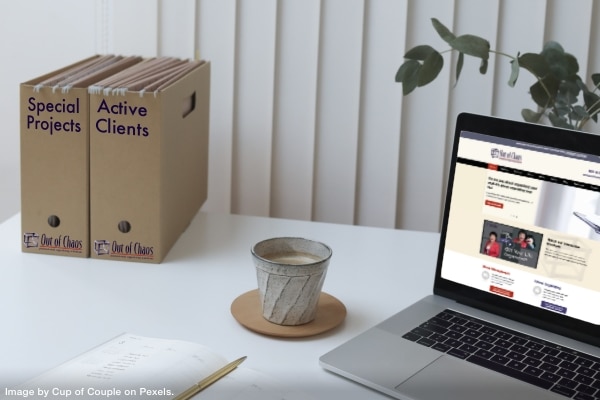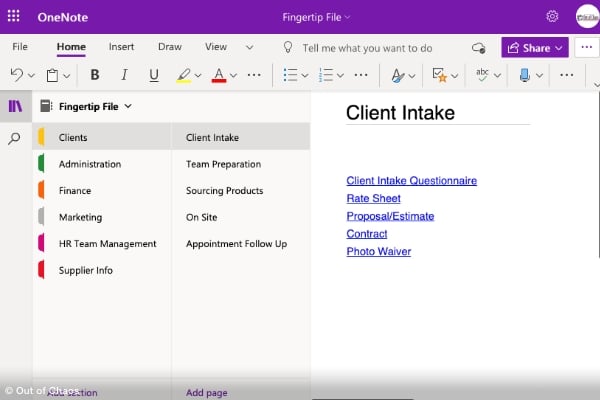
“Where did I put that information?” It’s a common and sometimes frequent question people ask themselves (me included). Perhaps you look for price lists, instructions, websites you frequently send to clients, and more. And maybe you store the data in multiple places, then become confused about the most up-to-date. What you lose in time, you gain in frustration because you don’t have a system to organize the information you need every day. Today’s post will discuss some options to help you solve this problem.
The Myth of the Paperless Society
Back in 1978, F.W. Lancaster predicted a paperless society in the “near future.” But in 2006, Statistics Canada revealed that the amount of paper we used doubled between 1983 and 2003. And many people still use paper today. In fact, I love my paper planner, and there are advantages to writing by hand. In short, no matter how many digital tools there are, the paperless society is a myth. Paper is here to stay. So, you should have a system to organize your paper and digital information.
The Two Types of Information You Need Every Day
Generally, you need two groups of information daily: active records and active reference material. Your active records are documents you must act on, such as a bill you must pay or a project you must finish. Active reference material is the information you need to take action on the active records. For example, I need the research paper from Statistics Canada (reference material) to write this blog post (the active record/project).
You might have some references that are active all the time. For instance, you never remember how to reset the timer on your coffee maker, so you want to keep the instructions handy. Or perhaps you need to provide quotes to clients when you’re speaking on the phone. Having your rate sheet easily accessible will make your calls go smoothly.
B-C.L.E.A.R. With the Information
Now that we’ve explained the type of information you need let’s use the Out of Chaos B-C.L.E.A.R. process to organize it.
Bring It Together
You likely have the information you need every day in many different places. The goal is to gather it in one place.
Firstly, get a box and put it on or beside your desk to collect all the paper-based information. It doesn’t have to be a fancy box, just something that will hold a stack of letter-sized paper (or legal-sized if that is what you most often use). Then, create a folder on your computer and add a shortcut/alias to your desktop. Name the folder “Info Needed Now” or something similar that resonates with you.
As you work through your week, put all the information you typically struggle to find into either the box or the computer folder on your desktop. Then, at the end of the week, you can take an hour or so to finish the C.L.E.A.R. process.
Categorize
Sort the information into broad categories such as work and home. Next, ask yourself if it is a project or information you need on an ongoing basis. Remember, a project has a defined endpoint, even if you will be working on it for a long time.
Afterwards, you can subdivide into smaller categories such as sales, finance, advertising, etc. Furthermore, note if you have the same information in both paper and digital format. If so, ask yourself:
- In which cases do I use the digital version?
- When do I use the paper version?
- Which version is the most recent?
Limit and Label
If you have multiple copies of the same information, keep only the most recent version, and move everything else to an archive folder. Next, create better names for the most recent digital file and place papers in labelled file folders so you can find them in the future. You can also secure papers with a clip and use a sticky note to label them.
Evaluate
Evaluating how long your information stays active will help you decide how long it stays on your (physical and virtual) desktop. For example, if you update your rate sheet annually, create a short process to move the new one to its designated location and move the outdated one to an archive folder. If you feel you have an overwhelming number of projects, read my advice on deciding to delete projects that no longer fit your goals.
It’s also wise to take a few minutes and evaluate your working style. Do you prefer paper or digital versions? Will you need to access information on the go? If so, how would you like to do that? Answering these questions will help you decide where and how to store the information you need every day.
Allocate
It’s time to allocate a place for your documents and data. For example, you could store all the project’s electronic documents in one folder on your hard drive. Then, create a shortcut/alias on your desktop. It is easy to access, and you can quickly add new information to the folder, so it’s all in one place. However, there are several ways to organize paper documents for a project, such as magazine holders or a mail sorter that you can put on your desk or hang on a wall.
Once you organize your projects, you can organize other information you use daily.
- Install and use a password manager on all your devices to increase efficiency and improve security.
- Cleaning up your contacts will help you optimize customer engagement, increase conversion, and build better relationships with customers, suppliers, and colleagues.
- Optimize your to-do list to maximize your productivity.
- Create a home for your notes and use it exclusively and consistently. You could choose a paper notebook, Microsoft OneNote, Apple Notes, Google Keep or a stand-alone product like Notion.
In the digital environment, create notes that link to all the files you regularly use, as you can see in my OneNote below. Mirror this system in a paper-based binder, portfolio or desktop file box.

Review and Remove
Finally, take a few hours every month to review and organize the information you need every day. Ensure you’re working with the most recent versions and decide if you must keep previous versions. If unsure, keep them in an “Inactive [document name]” folder. Then, when you confirm you no longer need to keep them, delete them. Set a reminder if you need or want to delete certain files on a specific date.
Although it may take a while to set up this system, you will reap the time-saving benefits day after day. If you’re interested in learning more about workplace productivity, feel free to book a time management workshop or read more of our tips on business organizing.
Image by Cup of Couple on Pexels.
